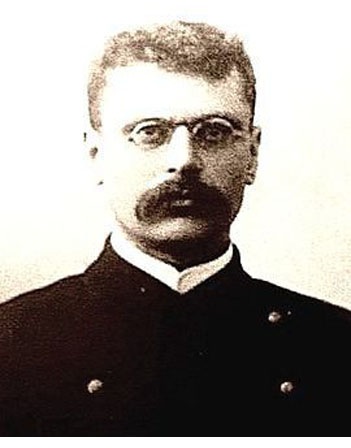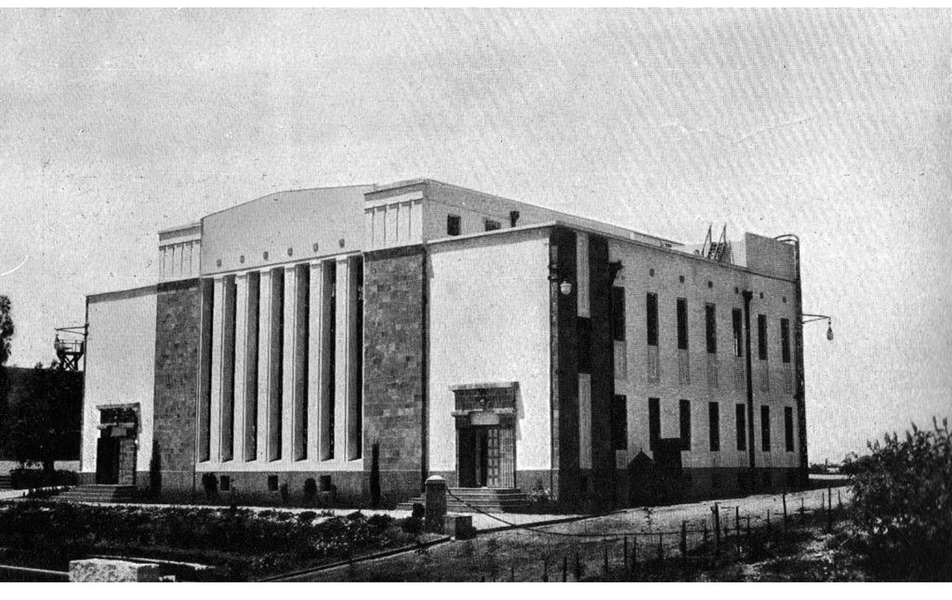PYOTR/PINCHAS RUTENBERG - IN RUSSIA AND IN ISRAEL

Pinchas Rutenberg
What Pipes doesn't mention is that, marching at Gapon's side, was the Social Revolutionary Pyotr Rutenberg who, after his student days, had become a worker in the Putilov works. According to Solzhenitsyn (p.396): 'In 1905 he trained groups of fighters in Petersburg and furnished them with arms. Inspirer of Gapon, he was at his side on the 9th January, 1905.' More detail is given in an article on the Tel Aviv street name website, based on research by Tel Aviv University Professor Matityahu Mintz (presumably translated rather awkwardly from an original in Hebrew): (7)
'Rutenberg heard from the workers at the Putilov factory about the intention to hold a mass march headed by Father Gapon. The march was supposed to march toward the Winter Palace to present a petition to Tzar Nicholas II of Russia. This demonstration took place in January and was called "Bloody Sunday". It marked the beginning of the revolution of 1905. Rutenberg reported the plan to his party leaders and they ordered him to take part in the demonstration and supervise its actions. He was an activist and also engaged in political assassinations, so he knew a thing or two about organising and demonstrating. He tried to persuade Father Gapon and his men to equip themselves with weapons and prepare escape routes ... Gapon never imagined that the revered ruler would shoot his soldiers / loyal sons. Of course, the naïve predictions did not materialise, and the soldiers fired at the unarmed crowd. The only one who did not lose his temper was Rutenberg. Having been ordered to follow Gapon. Rutenberg convinced Gapon to quickly cut his hair and shave his beard, and dress in ordinary clothes. Rutenberg then transferred the wanted priest by the authorities from one apartment to another until they hid him in the apartment of his best friend, the writer Maxim Gorky.
'On the orders of his party leaders, Rutenberg smuggled the priest out of Russia and accompanied him on his tours of European cities. The arrival of Gapon aroused great excitement with the leaders of the various camps of the Russian revolutionary movement. He became a sought-after guest in the home of Vladimir Ilyich Lenin and Krupskaya, as well as in the home of Plekhanov, the father of Russian Marxism. Rutenberg even brought him to Paris where he met Georges Clemenceau and Jean Jaures. As a faithful, conservative, and monarchist cleric, he did not find a common language with the radical revolutionaries. The only one with whom he had created a friendship with, was Rutenberg, whose status in the party because of his connections with him had been upgraded. In the meantime, the revolution in Russia gained momentum and Gapon missed his homeland and its workers rising on barricades. Rumours circulated [sic. circulating? - PB] in Russia about his hedonistic way of life, his visits to the casino and his contacts with women caused him to seek to purify his name again. He applied for a return and his request was accepted.'
(7) https://www.en.tlvstreets.com/Pinchas-Rutenberg.html. Mintz, a Polish Jew who escaped to Israel in 1941, died in 2016.
In 1906, however, after his return, Gapon was accused in Social Revolutionary circles of being a police agent and Rutenberg was instrumental in his execution. Since Azef, who really was a police informer, was involved in the accusation the whole affair is very murky.

Murder of Fr Giorgiy
(I'm by no means sure what the status of this picture is. Actual photo? Still from a film?)
Rutenberg's subsequent career is interesting. Apparently upset by his role in Gapon's murder, he took refuge in Italy, where he became friendly with the still Socialist Benito Mussolini. There, according to Mintz, 'he began to remember his Jewishness. Along with the understanding that the revolution would not, as many Jews believed, defeat anti-semitism and the atmosphere of national awakening that enveloped everything, made him "return to his people."' (Grammar as in original).
During the First World War he took up the idea of a Jewish Legion formed in support of the British 'liberation' of Palestine - an idea mainly associated with Jabotinsky, but Mintz felt Rutenberg's role had been underestimated. Mintz also argues that he continued his allegiance to the Russian Social Revolutionary cause: 'The evidence of maintaining the connection and preference for the interests of the party will be its [sic. his?] rapid and smooth integration in the future at the top of the government during the Kerensky Social Revolutionary period.' Kerensky appointed him deputy governor of Petrograd 'where he took a hard hand against opponents of the regime. It was reported that he had proposed to arrest and hang the Bolshevik leaders, Lenin and Trotsky, but the liberal and hesitant Kerensky refused.' He was one of the last to hold out against the Bolshevik coup in the siege of the Winter Palace. After a period of imprisonment he escaped Russia and turned up at the Versailles Peace Conference where he met 'his great friend Nahman Syrkin' (who is discussed in the last article in this series) in arguing for a recognition of Jewish national rights.
Subsequently, in Palestine, he introduced electricity to the country through the 'Jaffa Electric Corporation' (1921) which became the 'Palestine Electric Corporation Ltd' in 1923 (and the 'Israel Electric Corporation' in 1961). Solzhenitsyn, with his Zionist sympathies, approves: 'In 1919 he emigrated to Israel where he distinguished himself in the electrification of the country. There he showed that he was capable of building; but in the days of his youth in Russia, he was far from any work of engineering, he was a destroyer!'. He was one of the founders of the Hagannah and, with a well established strong man reputation, became leader of the Jewish National Council in the crises of 1929 and 1939.

First diesel-powered station in Tel Aviv, built in 1923 under the control of Rutenberg's Palestine Electric Corporation